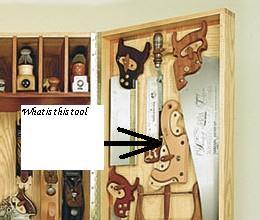Hello,
After studying the “Toolbox Book” many many times, I keep noticing a tool in several different tool boxes but I don’t know what it is. The tool in the toolbox (on page 101) by Greg Radley is in the middle of the facing right door – it seems to be a type of veneer saw… but I don’t know and have never seen one for sale in all the fine woodworking tool catalogues, and it is driving me crazy!
small photo attached.
Anybody know what it is, Thank you very much! Cheers
Jim

















Replies
It's called a stair saw or I've heard it also referred to as a dado saw or a sliding dovetail saw. It defines the cross grain boundaries of a dado so you can chisel or rout (with a router plane) the dado. Also you can make the angled cuts for a sliding dovetail with one.
The dados are commonly used to house stair treads, hence the name.
David C.
Edited 9/18/2006 1:43 pm ET by DCarr10760 Fixed Booboos :-)
Edited 9/18/2006 2:04 pm ET by DCarr10760
That was quick :-)
Thank you!
Cheers, Jim
It looks like an early 20th century rubber band gun. They were more simple then, my most recent one is a 12 shot model with a star-wheel that rotates to load and release each band.
A semi-automatic rubber band gun? Man! I'm always inspired by something when I hang around here.
I'll post a photo is I can find it. I bought it at a show here called "Toys For Adults" which of coarse, we renamed "Toys For Dolts". Nothing kinky, just goofy stuff.
"I cut this piece four times and it's still too short."
Looks like a staircase saw with the blade retracted. I saw Roy Underhill use one of those sweet babies on The Woodwrights Shop to cut the side of a sliding dovetail that didn't go all the way through the board. The blade can be set at a certain depth and is stout enough you can "punch" the saw through the wood. He drilled a hole at the end of his sliding dovetail so that the sawdust from the teeth would have someplace to go.
Hi Jim,
Like the others have said, it's a stairsaw. In the foreground is one I made and shows what a blade is like when removed.
http://wenzloffandsons.com/saws/cc/cc_0001.jpg
Take care, Mike
Nice stair saw, Mike!
Historically, did they usually adjust? If so, how did they make the adjustment?
(Hmmm, might have to put one of those on the list...)
David C.
I made one as well, a little longer than the norm. The next one will be shorter.
View Image
The extra depth was so that it could be used against a fence to cut sliding dovetails.
Regards from Perth
Derek
Thank you, David and Mvflaim!
All my vintage examples, including some European ones, have adjustable blades.
The saw blade is new steel. This particular stair saw was made to cut sliding DTs in wide material. And so there were a few considerations. One, tooth count. It needed to be low enough to cut efficiently and high enough to be fairly smooth. Two, the blade depth needed to be such that it could be used with a guide block for the angle. Three, we needed to lower the angle that the handle "hangs" so one is pushing along the kerf line more than down into it.
Well, that's the rationale anyway. It works good. Traditionally when used on Pine and Fir for letting in stair treads, they were typically aggressive and the handle hang really pushed into the wood. Combined with the shortness they cut quick in soft material. Just not optimum for a cabinet maker trying to cut finer joinery.
Here's a shorter, higher hung one:http://www.wenzloffandsons.com/saws/images/stair.jpg
Take care, Mike
Have a look at the ece catalog, http://www.ecemmerich.de/images/ece_katalog_07_deutsch.pdf
They still make it!
Geert van der Donk
Mike, did you cut that blade from an old saw or did you make it from scratch? Nice saw!
Thanks MikeTell me and I'll forget, show me and I'll remember, but let me try and I will understand.
This forum post is now archived. Commenting has been disabled